Circuit description
Measurements
More tests on mixer dynamics
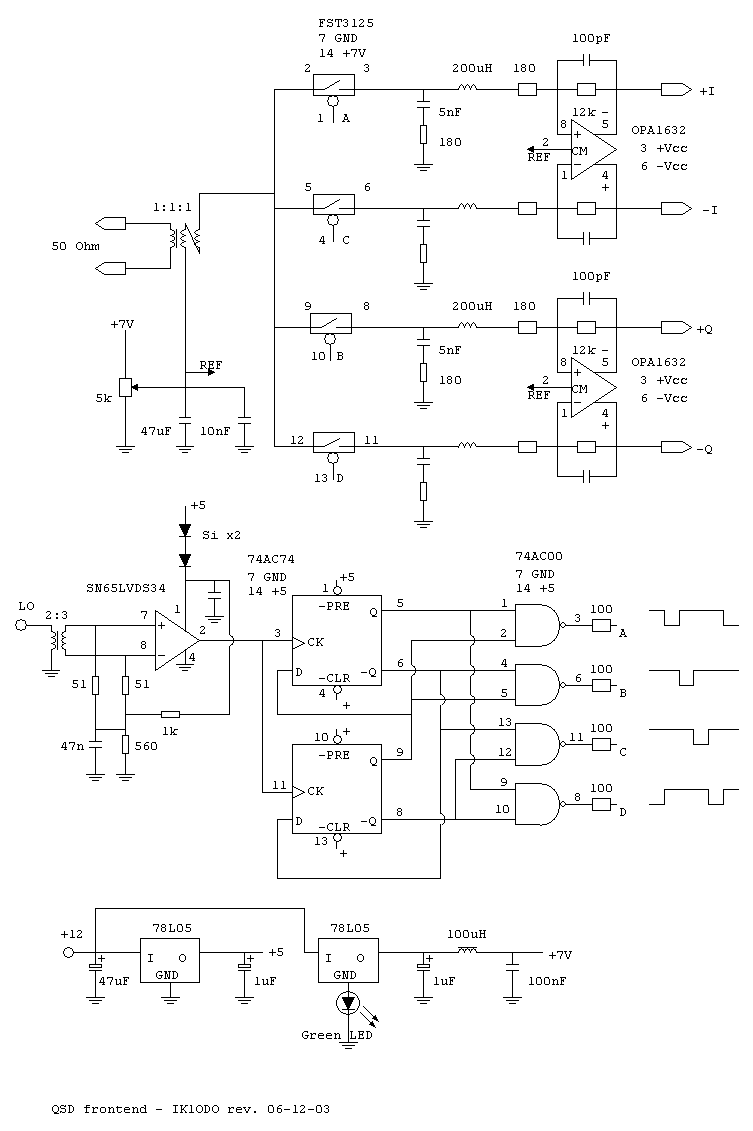
An high dynamic range QSD front end
IK1ODO
Dec. 2006
A few months ago
I bought and built a SoftRock. The first results have been very
exciting, the performance was very good. After a couple days of
listening in 40m I begun questioning about the dynamic range of the
thing: it was intermodulating, and a variable attenuator was needed
in input to use it in Europe. So I modified the SoftRock opamp stage,
since that was the bottleneck, and started thinking about a better
implementation of the QSD. I used ideas from several authors, in
particular from the AIQSD
of Ahti OH2RZ.
I have
then bought five different audio boards, and I'm currently using an
EMU 1616 (not 1616M) and a 1212m. The latter uses the same AK5394A
selected for HPSDR
in Janus, and is a very good product.
With the 1212m the measured
dynamic range (noise floor to saturation) in 2.4kHz of band is in the
order of 125dB. I started thinking that a front-end with more than
120dB of dynamic range, without preamplifiers, attenuators or AGC
would have been a very interesting thing. So this project begun;
after about three months I have a prototype with -128 dBm of noise
floor in 2.4kHz, and -3dBm of saturation level. I think that this
could be a good starting point for a complete high performance QSD
receiver; perhaps a good base for the Phoenix board in HPSDR.
The
main measured characteristics of the current circuit are:
Low gain audio interface setting (+4dBu f.s.)
RF input level for
A/D converter saturation: -3dBm
SFDR:
90dB with -10dBm RF input
Noise
floor: -123dBm / 2,4kHz
3'
order dynamic range: 105 dB
IIP3:
+36dBm
High gain audio interface setting (-10dBu f.s.)
RF input level for
A/D converter saturation: -17dBm
SFDR:
100dB with -20dBm RF input
Noise
floor: -128dBm / 2,4kHz
3'
order dynamic range: 102 dB
IIP3:
+25dBm
Circuit
description
Measurements
More
tests on mixer dynamics
Circuit
description
I used a four-phase, single balanced mixer
with a 90° conduction angle, as suggested by Dan N7VE in his
papers. The 90° conduction angle should be the best compromise
for a low loss, according to simulations by Phil N8VB.
The sampler
is an FST3125. Having no internal decoding logic it should have the
best switching symmetry.
The divider chain is the classical
Johnson ring counter, driving a four-NAND gate. The LO signal by now
is delivered by a Rohde&Schwarz SMHU58 signal generator.
The
LO signal appears at the antenna port, but it's quite attenuated,
with a -60 dBm or lower level. LO harmonics are stronger, but may be
stopped by the input low-pass filters. I think that the the low LO
radiation indicates a good mixer balance. Here is a typical LO
radiation spectrum at the RF port: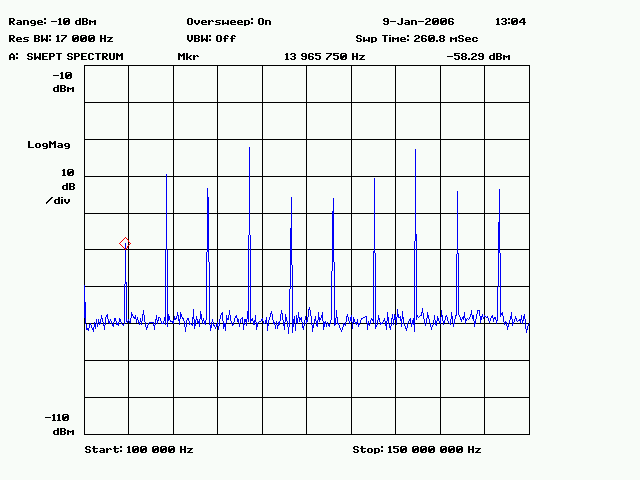
The RF
signal is translated to a 200 Ohm impedance. The input transformer,
not critical, is a trifilar winding on a ferrite binocular. The
impedance seen by each opamp input is 800 Ohm (four times the mixer
inputr impedance), offering an acceptable match with the opamp noise
impedance (more later on this).
A diplexer follows the mixer,
performing two functions: it offers a constant impedance to the
mixer, and so to the RF port, and avoids out of band signals reaching
the opamp. I had many discussions on this point, so I want to clarify
my considerations.
The input impedance of the classical Tayloe
mixer changes with F, and is difficult to predict. Measurements done
on the SoftRock show impedances far from 50 Ohm, so the preselection
filters have no definite termination impedance. Then, at sampler
outputs there are many fast signals and spikes, mainly at LO
frequency, with harmonics up to the UHF region. The opamp shows a
virtual short circuits to all signals within its loop bandwidth, but
the input stage can't handle fast transients without going in a
non-linear operation. So, a diplexer is necessary for this purpose;
see below for a measurement of switching transients.
Cutoff
frequency of the diplexer is around 250kHz, not critical. It should
be out of the audio pass band (96kHz) and inside the GB product of
the opamp. The impedance of the diplexer is 200 Ohm, since when a
switch is open it must see the RF port impedance. The impedance of
the RF port is very close to 50 Ohm from 1 to 50 MHz. Have a look at
the impedance plot (S11 at RF port):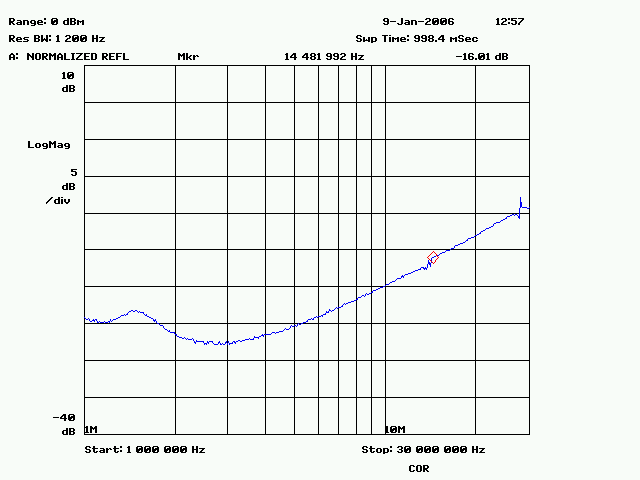
Post-mixer
amplifier
Following a schematic published by Ahti OH2RZ I
used a fully balanced configuration, using an OPA1632. That seemed
correct to me, having to drive a balanced load from a balanced
source. The opamp is powered from +/- 12V to have enough dynamic
range. Many opamps show the best IMD and distortion if the output
swing is below Vcc/3, and the high-end audio cards accept 4 Vrms as
maximum input level (+10dBu plus a margin). An instrumentation
amplifier is not very useful, since they have high noise at low gain
settings.
The opamp contributes with his noise to the total noise,
of course. How much? The noise in an operational amplifier is
modelled with a voltage source (En) in parallel to the inputs and a
current source (In) in series. Now, En/In=Rn, that is an equivalent
noise resistance. The opamp gives the minimum noise contribution when
the source resistance is equal to Rn. For the OPA1632 this value is
3.25 kOhm, difficult to obtain in a wideband RF circuit.
The
opamp's noise figure would be 0.53dB if closed on 3.25 kOhm; in our
case it sees about 1k Ohm,and the figure becomes 0.72dB.
Incidentally, using four expensive AD797 would give a 0.4dB noise
improvement; not worth that, in my opinion. If somebody is interested
I have an Excel spreadsheet to compute the opamp's NF given In, En
and the source R.
Sampler noise
The switches
of the FST3xxx family (and similar switches) in theory are not noisy
devices. Internally there is a simple CMOS switch connecting input
and output, so the only noise produced should be the thermal noise of
Ron (4 Ohm), very small. However things are different, as any
experimenter that did noise measurements on a QSD receiver knows. The
device is noisy, and noise increases with F; the SoftRock had a great
success mainly as a 40m receiver.
I think that the noise
derives from the switching process itself. Transients are coupled to
the channels via the gate capacitance, driven by a 0-5V pulse. The
gate-channel C is unknown, but probably is in the 5pF range.
So
I started to work on the switching noise, and I discovered that it
decreases:
- using 74AC series gates (I started with 74F logic)
-
putting 100 Ohm resistors in series to the outputs of the 74AC00
-
powering the FST3125 at 6.8V (7V is the maximum allowed)
But,
even more interesting, the noise decreases by several dB changing the
polarization voltage at the input of the FST3125, traditionally put
at Vcc/2. If you look at my circuit there is a potentiometer to vary
the Vref. I consider this one a very important point: Vref must be
changed increasing the LO frequency. There is a minimum noise value,
very broad at 7 MHz, but more critical at 29 MHz. Changing this bias
I obtain -127dBm noise floor (in 2.4kHz IF band) from 1.8 to 21MHz,
and -126dBm at 29 MHz. The mixer still works at 40MHz, then the
flip-flops stop working, so I have no data for 50MHz.
I have
no idea of the reason for this behaviour, and about the dependency
from the LO frequency. In any case, here are the transients measured
on pin 3 of the FST3125, in two different time scales. My 'scope has
only a 1GHz band, and I suspect that the band of the transients may
be wider. Compare this with the necessity for a diplexer in front of
the OPA1632; the transients are in the order of 600mV peak-to-peak.
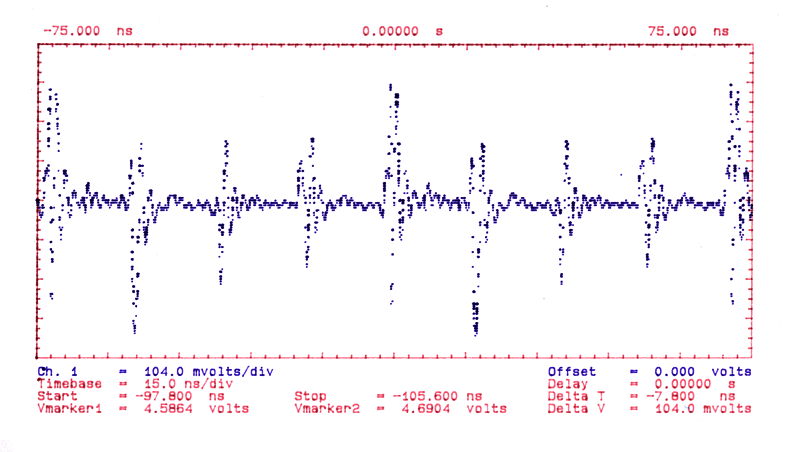
The same signal at 1ns/div. The slew rate is limited by the 300ps rise time of the oscilloscope.
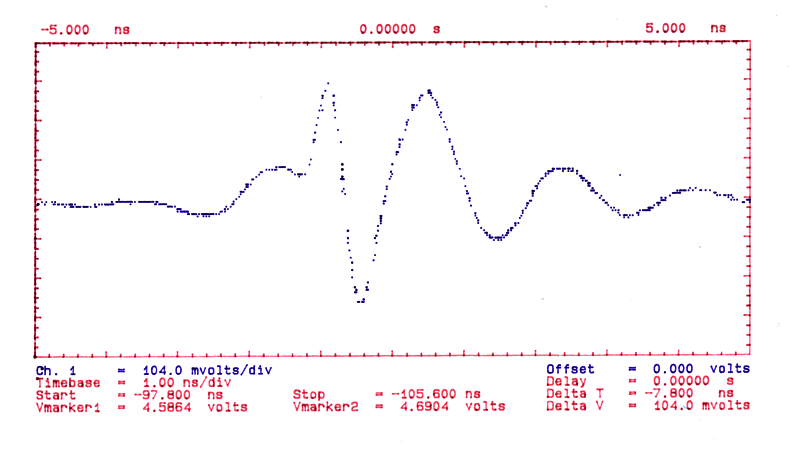
A
rule-of-thumb noise
extimate...
If
the noise floor is -126dBm in 2.4kHz then the NF is about 14dB. Three
dBs are lost in the diplexer resistors, about one dB is the opamp
noise contribution, something (another dB?) is contributed by the
audio board and from input transformer losses, another dB is lost in
the 90° sampling process. My extimate of the mixer ENR is about
8dB; so there is still room for improvement, and indeed tweaking with
parameters on a slightly different circuit I arrived at -132 dBm at
14MHz (always in 2.4kHz).
Work to do
The current
circuit is mounted dead-bug on a piece of PCB, and it works well.
There are still several points for experimenting:
1)To test
different bus switches, and different brands of FST3125, or a FST3126
changing the NAND gates to AND. An interesting switch is the FSAV332,
but it is small, and requires a PCB. A friend is designing the PCB,
so I will do this test soon.
2)Between the NAND and the switch,
optimize the value of the dumping resistors. Possibly the slew rate
is important.
3)Divider chain. To arrive at 50 MHz requires faster
logic, but able to drive the switch.
4)Input filters. I observed a
large rise in noise (approx 4dB) fitting a 5-pole low-pass filter.
This may be due to the improper termination of switching transients.
I hope to find a way to improve the input matching, without having to
fit a diplexer for every different filter...
I expect to do
more tests in next weeks, and then publish the
results.
Measurements
More
tests on mixer dynamics
73 de Marco
IK1ODO